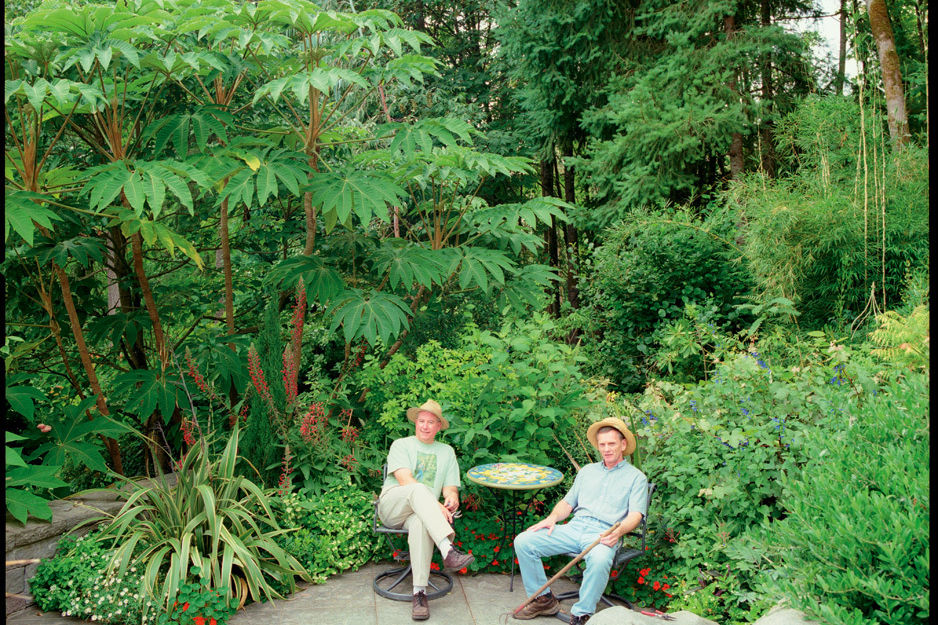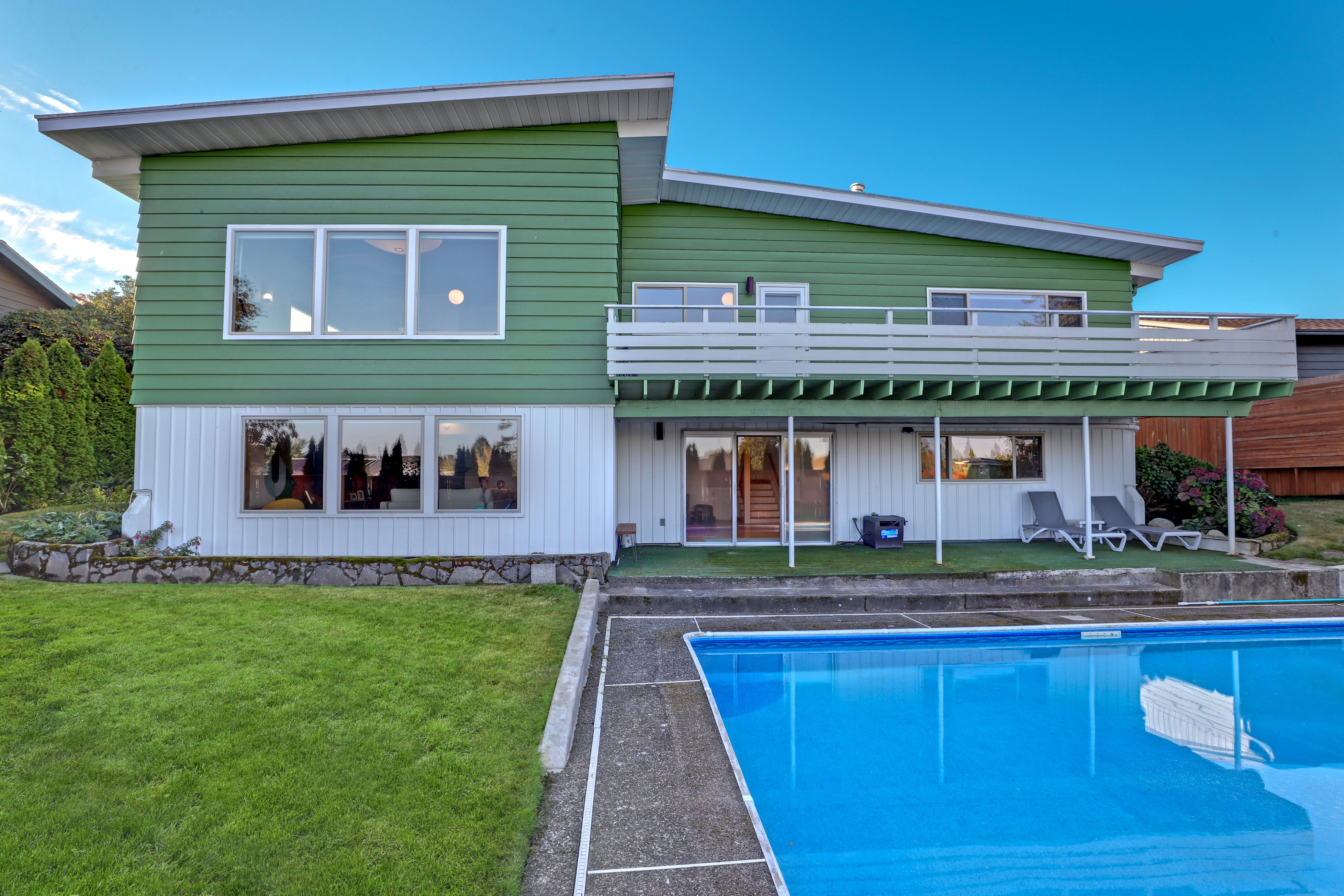A Garden in the Forest
"THESE WERE SUPPOSED TO BE PURPLE," Jerry Grossnickle confesses, pointing to a cluster of cream-colored lilies and smiling almost ruefully. On an overcast, late-summer afternoon, the myriad flowers in his garden—a lush two acres along NW Old Germantown Road about a mile west of Forest Park—take on an almost preternatural brilliance. Grossnickle’s longtime partner, Bruce Wakefield, reaches for one of the blooms, which is almost as pale as his spotless oxford. The colors of lilies vary according to weather and age, Wakefield points out; maybe they’ll bloom the right shade of rich lavender next year.
In that sense, the lilies are a work in progress, as is the garden itself—a spectacular, steeply sloping expanse that Grossnickle, a 60-year-old lawyer, and Wakefield, a 54-year-old accountant, designed, planted, and continue to maintain themselves. And despite a few failed experiments, this horticultural labor of love is a brilliant piece of landscape design and a testament to the patient art of collecting and raising exotic plant specimens from around the world.
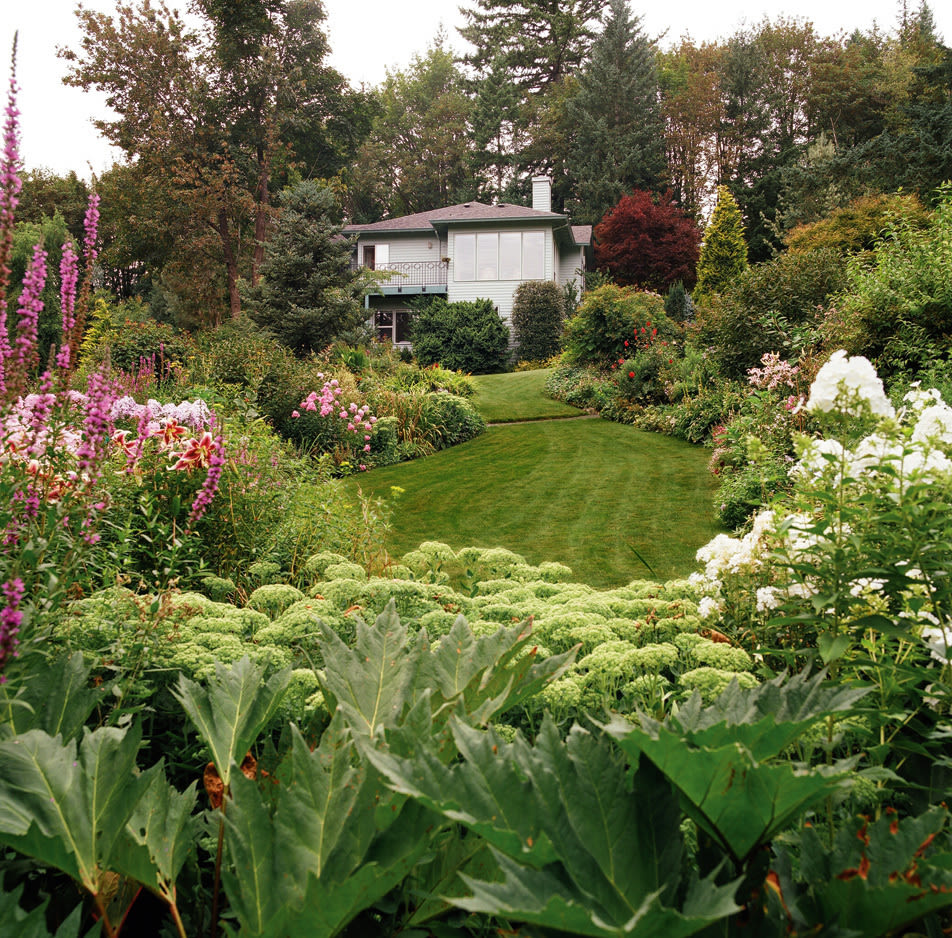
BUILDING BLOCKS Broad-leafed ornamental rhubarb and the budding heads of sedum (foreground) lend structure to billowing beds of summer blooms.
Image: Susan Seubert
Following the curve of a stream that runs intermittently along the cooler eastern side of the property, Grossnickle leads the way down the hill, away from the two-level house overlooking the site, which the couple built in 1990. A narrow green swath of lawn, flanked by mixed borders of shrubs and perennials, sweeps down to the base of the incline, where fat, glistening koi trace lazy circles in the shallows of a hand-dug pond.
“This slope is one of the reasons we bought the property,” Grossnickle says. “We knew that it would make a great garden spot.”
Actually, the lush creation, which Wakefield modestly describes as “a collection that we’ve tried to put into an interesting design,” contains several gardens in one, each reflecting the distinct microclimates of the entire five-acre plot.
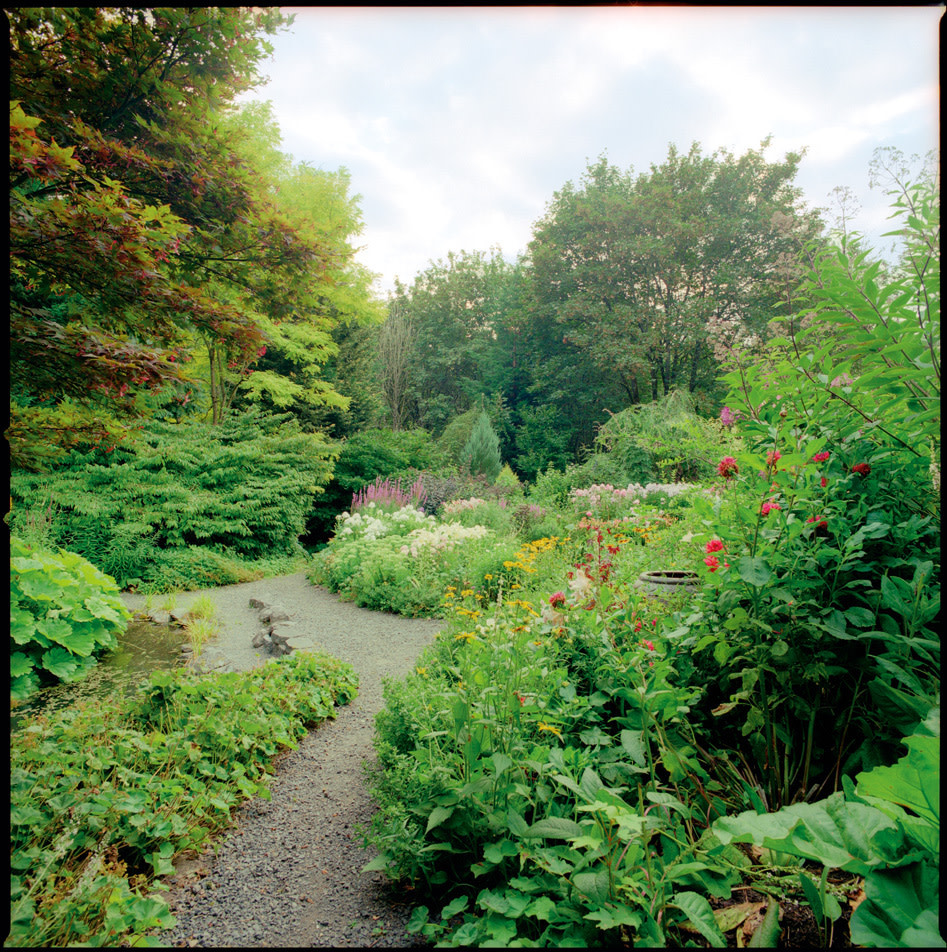
FLORAL PARADE Mixed borders of dahlias, black-eyed Susans, and white and pink phlox march toward the edge of the “woodland garden.”
A path at the bottom of the hill turns right, leading into Wakefield and Grossnickle’s “woodland garden.” Densely planted with magnolia trees and various species of rhododendrons, this shady hideaway blossoms with Himalayan candelabra primrose come spring. From here, the path arcs back up the slope for about 30 yards, and emerges from the forest canopy into a grove of rare dwarf conifers, including the feathery, golden Port Orford cedar. It then winds past a blueberry patch and two Japanese raisin trees—and culminates in a series of terraced beds and patios beneath the couple’s second-story living room. On this warmer, southwestern-facing quadrant of the property, Wakefield and Grossnickle have created a Mediterranean rock garden, where beds bulge with tricolor sage, the pale pink blooms of the pineapple lily, and spiny clutches of agave grown from seed. The giant, primordial-looking leaves of the rice-paper plant—the kind Wakefield grew up with in California—loom above a rock wall whose design was inspired by ancient Incan architecture.
The couple, who met in 1987 at an Old Town piano bar, first bonded over their interest in home improvement; at the time, both had remodeled their early 20th-century Portland homes and were gardening on their small city lots. Within a few months, the pair purchased the Forest Park property with the intention of planning a shared house and garden on a much grander scale, a prospect that was especially intriguing for Wakefield: Though very much a beginning gardener, he was quickly outgrowing his space.
“I’d built this gigantic deck in my backyard,” Grossnickle recalls, “and when I met Bruce, he began commandeering it for all his orchids.”
When they bought the new lot, it was covered entirely with brambles and scrub trees. (Probably canopied in native fir once, the land was logged in the 1930s, they believe.) It took two years to clear two acres by chain saw, at which point they were left with a muddy, uneven hillside punctuated by natural springs and soaked with large swampy areas during the winter months. To counter the sogginess, Grossnickle laid hundreds of feet of corrugated plastic pipe in rock trenches to draw off standing water, and guided the stream by digging its bed deeper into the hillside. He also built the garden’s footpaths, many of which follow old deer trails; thanks to the installation of a weed barrier and a total of 164 tons of gravel, they remain passable during even the heaviest of January rains.
Wakefield, meanwhile, busied himself buying plants, patronizing mail-order seed companies such as Jelitto Perennial Seeds and local sales like the one hosted annually by the Hardy Plant Society, a nonprofit dedicated to promoting herbaceous perennials. Hoping to increase his ratio of knowledge to enthusiasm, he bought gardening book after gardening book and, impressed with members’ horticultural expertise, joined the Hardy Plant Society. (He’s now its president.)
“I’m a plantaholic and a collector, and I want everything,” Wakefield laughs, admitting that he hides from Grossnickle just how much he spends on his prized flora; they’ve agreed it’s easier that way.
Visible from their home today is a veritable United Nations of flora, with Chinese beesia and Japanese maples sharing space with Pacific Coast redwoods and the pretty, pink-tinged blooms of Siskiyou pink gaura. The couple conservatively estimates that they have more than 2,000 different kinds of plants. And though they make space for familiar faces like sedum and phlox, their hearts belong to exotics.
“Natives are allowed to stay if they’re well-behaved and have ornamental interest,” Wakefield says with a smile.
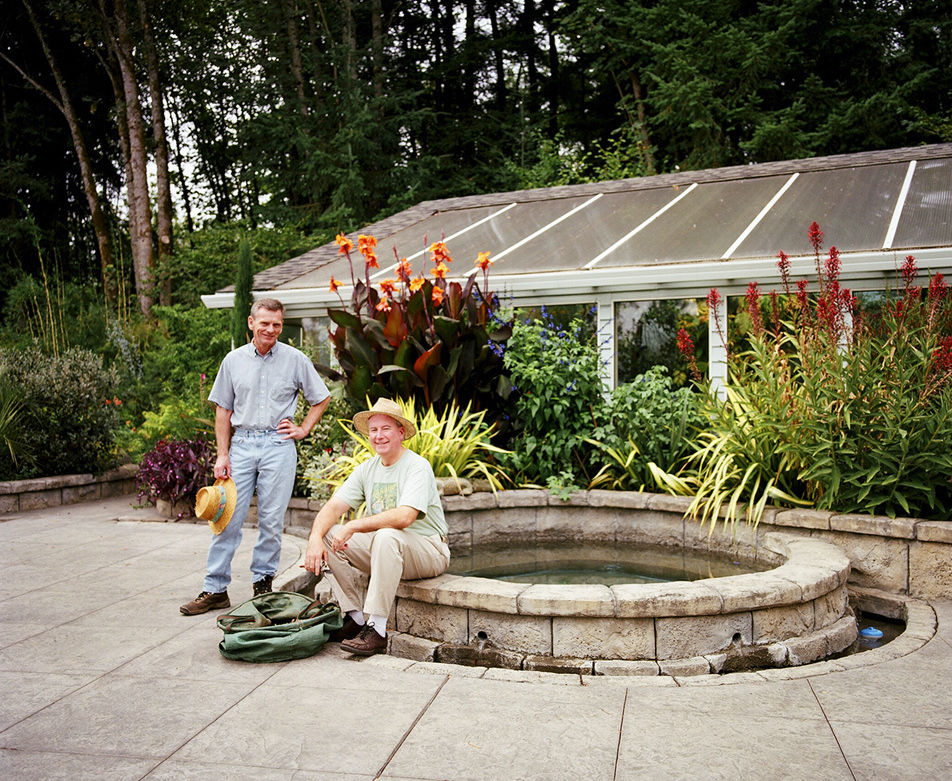
SPLASHY COLOR Flame-hued canna lilies and red spears of Lobelia tupa form a fiery backdrop for a plunge pool that feeds a waterfall on the lower terrace.
Image: Susan Seubert
One of their “signature plants,” he says, is the giant Himalayan lily, which, when planted from seed (purchased from Jelitto), spends the first six years of its life as a small, uninspiring little shoot. In June of its seventh year, though, the plant rockets skyward into an 11-foot-tall spire; puts forth a circle of glorious, white, trumpet-shaped blossoms with purple throats; and then promptly expires. In 2007, 19 of their Himalayan lilies bloomed at the same time, and Wakefield sounds almost giddy when describing the display.
Considering the patience required to raise such a specimen, it’s not surprising that Wakefield and Grossnickle have spent nearly two decades creating their estate-sized paradise, most of which is made up of wooded acres that connect with Forest Park. They tend to the entire property themselves, a task that demands roughly 20 hours a week, year-round, from each. Moreover, they do so without the aid of fertilizers, herbicides, or pesticides, and they mulch and weed and water by hand. After all, they’re not interested in poisoning their own well water, from which they drink. Besides, Grossnickle maintains, chemicals aren’t needed if you plant your garden correctly.
“If you establish a balance in your garden, the bugs and the birds and the critters sort of duke it out,” he says.
So the only thing that really threatens their Edenic real estate is the possibility of human encroachment. Since it lies just a mile outside the city’s urban growth boundary, in a region where developable land is valued at hundreds of thousands of dollars an acre, Wakefield and Grossnickle are working to get legislation passed that would designate the area where they live, between Forest Park and Washington County, a rural reserve. They also make sure to keep most of their property sufficiently wooded and wild, and no doubt the deer, the elk, the eagles, and the coyotes—all of which have made visits—appreciate it.
And as for the landscaped part? That will keep evolving, the two agree. Grossnickle says that they’ve been gradually replacing some of the high-maintenance perennials with shrubs and small trees.
“We’ve been gardening here for 16 years,” Wakefield says, “so the next 16 years will be spent educating ourselves on how to have a great garden and spend less time maintaining it.”
Of course, one option would be to let the garden go wild. But it’s doubtful these avid collectors will go that route; there are too many distant landscapes—and exotic lilies, flaxes and euphorbias—to enjoy in their own backyard.
